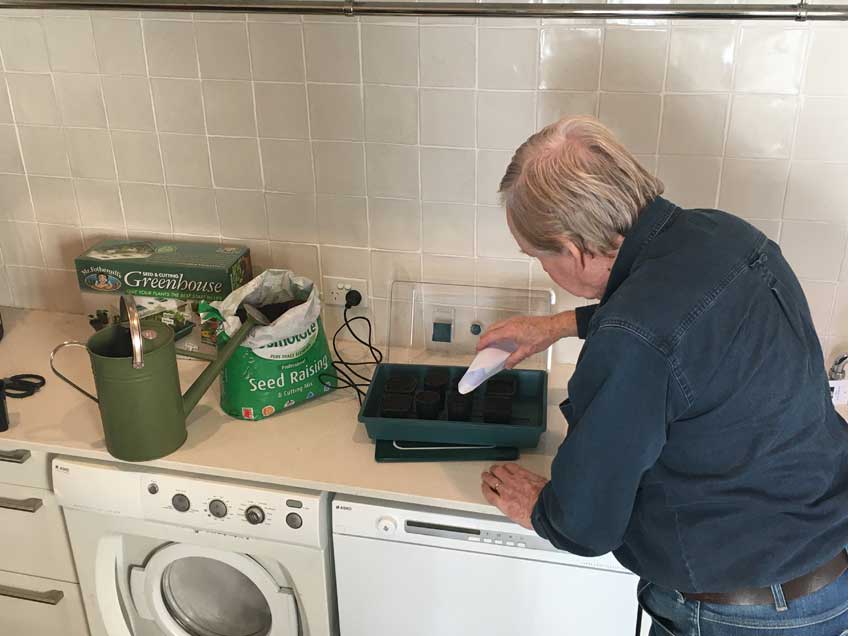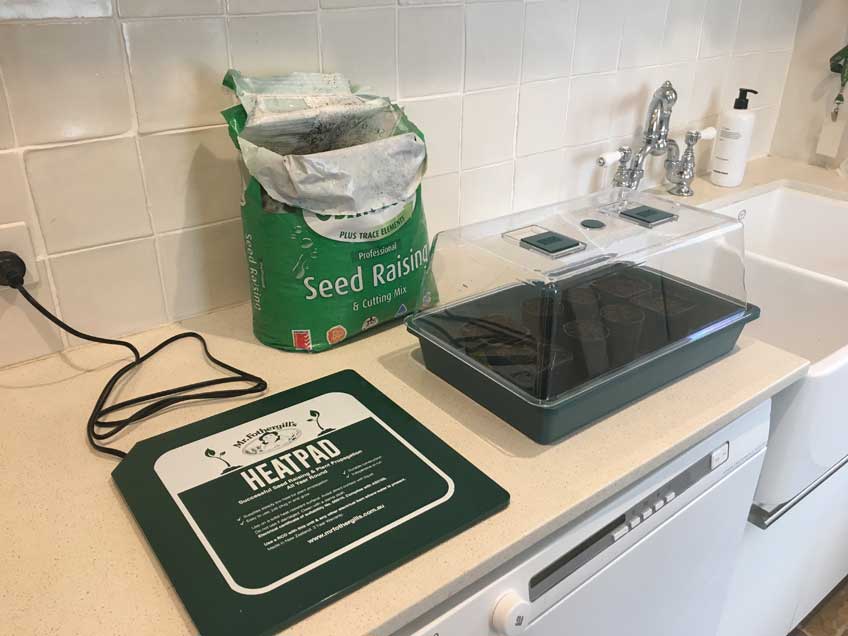July is a good time to sow tomatoes. It takes 6 to 8 weeks for seeds to germinate and seedlings to grow big and strong enough to be planted out in the vegetable garden.
If you live in a frosty region you should wait six to eight weeks before the last frost. We have set up our mini greenhouse (Mr Fothergill) with its heat pad to supply steady low heat for plant propagation, in this case it’s to germinate our tomato seeds.

Graham sowing tomato seed of Cuore Di Bue Rugantino in mini greenhouse with heat pad.
There are hundreds of tomatoes to choose from. The big interest is in Heirloom varieties. We decided against the old varieties because of our experience
over the last few years when disease ruined our crops. We have chosen Cuore Di Bue Rugantino F1. It’s a modern variety of the famous Italian Oxheart
tomato from Lambley Nursery. We agree with David Glenn that this modern F1 hybrid should have more vigour and disease resistance. Lambley have lots
of fabulous varieties in their catalogue. Their most popular is a new top-quality Roma called ‘Katya’ which fruits for three months!

Mini greenhouse and heat pad
Pic caption: Tomato Cuore Di Bue Rugantino
Tomatoes … Heirlooms versus Hybrids
Here is what David Glenn wrote on “heirlooms versus hybrids” in his garden notes on Lambley Nursery website …
"Over the last decade or so commercial seed companies have been putting a lot of effort into breeding flavoursome tomatoes. It’s no easy task as commercial
growers also need high disease resistance, heavy cropping and good shelf life. The better a tomato tastes the higher the price commercial growers receive
for their product. Consequently, they are willing to pay more for seed of good varieties. This has spurred competition between seed companies to breed
ever better tomatoes.
The result of this work is now becoming available to home gardeners and some new commercial tomato varieties have terrific flavour.
Not that this flavour is better than some of the best “heirloom” varieties such as ‘Brandy Wine’ and ‘Black Krim’. The problem with most heirloom varieties
though is their lack of disease resistance. Many people just can’t get a decent crop, or any crop at all, from these older varieties.
Tomatoes suffer from a plethora of viral, bacterial, fungal and root knot diseases. It’s the pressure of a combination of these diseases which makes growing
“heirloom” varieties increasingly less rewarding." David Glenn
And this also from David … “Half a century ago I knew this old Melbourne gardener who prided himself on his ability to grow and pick a decent crop
of ripe tomatoes by Christmas. No mean feat in Melbourne. He didn’t have any fancy pants propagating systems. During late winter he sowed 2 or 3 tomato
seeds 5mm deep in each of half a dozen 7.5cm well-watered pots. He placed the pots in a metal tray and sat the tray on his indoor hot water tank. The
seeds germinated within a couple of weeks.
After germination he thinned the pots to one seedling per pot and during mild days would sit the tray on some steps on the north side of his house. The
plants would be brought inside overnight. During periods of heavy rain the tomatoes would be kept indoors. In early September he potted the tomato
plants into 15cm pots. These were kept them outside as long as there was no danger of frosts.
The by now 60cm tall tomatoes would be planted out into their permanent position in the garden by the end of October. He was lucky enough to live in an
area where there were no spring frosts. And voila by Christmas some nice ripe tomatoes.”